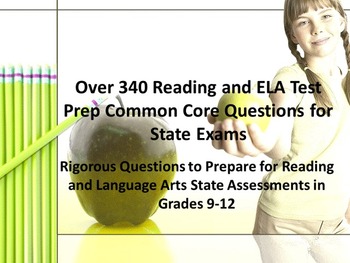340 High School Reading and ELA Test Prep Common Core Questions for State Exams
JCBEdPRO
610 Followers
Grade Levels
9th - 12th, Homeschool
Subjects
Resource Type
Standards
CCSSRL.9-10.1
CCSSRL.9-10.2
CCSSRL.9-10.3
CCSSRL.9-10.4
CCSSRL.9-10.5
Formats Included
- PDF
Pages
15 pages
JCBEdPRO
610 Followers
What educators are saying
This has become a standard to help me come up with test prep prompts and help students prepare for tests.
Description
Are you looking for a test prep resource that will help your students be prepared for the types of questions that they will see on your reading and language arts state exams? The following resource includes 340 rigorous questions patterned after released state exams as well as the question banks from print and electronic resources from some of the top test prep vendors. You will not find a question stem bank this large and diverse anywhere! This tool is the ideal test prep tool for grades 9-12 because it uses the specific wording that will be used on the state exams. The question stems are separated by topics in reading and ELA including the following areas:
Reading Literary and Informational Texts:
• Theme
• Plot Structure
• Characterization
• Point of View
• Main Ideas and Supporting Details
• Summarizing Texts
• Connections and Distinctions
• Drawing and Supporting Inferences
• Author's Purpose
• Figurative and Connotative Meanings
• Word Choice and Tone
• Paragraph organizational Structure
• Author's Argument, Claims, and Evidence
• Drama Structure
• Suspense and Humor
Language Arts:
• Introduction and Concluding Sentences
• Supporting and Developing Topics
• Appropriate Transitions
• Varied Sentence Structure
• Precise Language and Sensory Details
• Task, Purpose, and Audience
• Revising and Editing Writing
• Gathering Relevant Information
• Citing Information
• Using Verbs in Mood
• Active and Passive Voice
• Reference Materials
• Figures of Speech
• Denotations and Connotations
• Context Clues
• Roots and Affixes
• Word Relationships (Synonyms and Antonyms)
Teachers can use the resources to expose students to the specific wording that the state exams will use. These question stems can easily be implemented with any core text or activity, and students will be able to identify the different ways in which a topic can be addressed using a variety of question types. The questions are excellent tools for close readings of informational and literary texts, text annotation activities, and creating challenging and rigorous assessments. Students who use this resource will be well prepared for any state exam.
340 High School Reading and ELA Test Prep Common Core Questions for State Exams by Dr. Joel C. Boyce is licensed under a Creative Commons Attribution 4.0 International License.
Reading Literary and Informational Texts:
• Theme
• Plot Structure
• Characterization
• Point of View
• Main Ideas and Supporting Details
• Summarizing Texts
• Connections and Distinctions
• Drawing and Supporting Inferences
• Author's Purpose
• Figurative and Connotative Meanings
• Word Choice and Tone
• Paragraph organizational Structure
• Author's Argument, Claims, and Evidence
• Drama Structure
• Suspense and Humor
Language Arts:
• Introduction and Concluding Sentences
• Supporting and Developing Topics
• Appropriate Transitions
• Varied Sentence Structure
• Precise Language and Sensory Details
• Task, Purpose, and Audience
• Revising and Editing Writing
• Gathering Relevant Information
• Citing Information
• Using Verbs in Mood
• Active and Passive Voice
• Reference Materials
• Figures of Speech
• Denotations and Connotations
• Context Clues
• Roots and Affixes
• Word Relationships (Synonyms and Antonyms)
Teachers can use the resources to expose students to the specific wording that the state exams will use. These question stems can easily be implemented with any core text or activity, and students will be able to identify the different ways in which a topic can be addressed using a variety of question types. The questions are excellent tools for close readings of informational and literary texts, text annotation activities, and creating challenging and rigorous assessments. Students who use this resource will be well prepared for any state exam.
340 High School Reading and ELA Test Prep Common Core Questions for State Exams by Dr. Joel C. Boyce is licensed under a Creative Commons Attribution 4.0 International License.
Total Pages
15 pages
Answer Key
N/A
Teaching Duration
Lifelong tool
Last updated Jan 6th, 2014
Report this resource to TPT
Reported resources will be reviewed by our team. Report this resource to let us know if this resource violates TPT’s content guidelines.
Standards
to see state-specific standards (only available in the US).
CCSSRL.9-10.1
Cite strong and thorough textual evidence to support analysis of what the text says explicitly as well as inferences drawn from the text.
CCSSRL.9-10.2
Determine a theme or central idea of a text and analyze in detail its development over the course of the text, including how it emerges and is shaped and refined by specific details; provide an objective summary of the text.
CCSSRL.9-10.3
Analyze how complex characters (e.g., those with multiple or conflicting motivations) develop over the course of a text, interact with other characters, and advance the plot or develop the theme.
CCSSRL.9-10.4
Determine the meaning of words and phrases as they are used in the text, including figurative and connotative meanings; analyze the cumulative impact of specific word choices on meaning and tone (e.g., how the language evokes a sense of time and place; how it sets a formal or informal tone).
CCSSRL.9-10.5
Analyze how an author’s choices concerning how to structure a text, order events within it (e.g., parallel plots), and manipulate time (e.g., pacing, flashbacks) create such effects as mystery, tension, or surprise.


